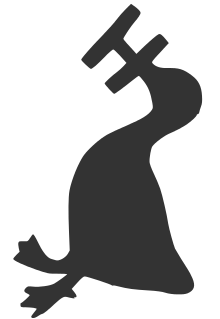Håkås
| Håkås | |
|---|---|
 | |
| Location | Båstad, Trøgstad, Norway |
| Coordinates | 59°40′48″N 11°15′56″E / 59.680092°N 11.26545°ECoordinates: 59°40′48″N 11°15′56″E / 59.680092°N 11.26545°E |
| Elevation | 185 metres (607 ft) |
Håkås (pronounced [hɔkɔs]; from Old Norse Haukáss, "hawk hill"), formerly spelled Haagaas and Haakaas, is a small hill near the lake Øyeren in Båstad in Trøgstad, Østfold, Norway. It is also the name of three neighbouring farms in its immediate vicinity, known as Håkås Nordre (Northern Håkås), Håkås Søndre (Southern Håkås) and Håkås Mellom (Middle Håkås),[1] which were historically two and originally possibly one farm. Håkås borders Agnes to the north and Engen to the south. Håkås is located around 35 kilometres southeast of the city centre of Oslo and 25 kilometres southeast of Oslo's municipal borders. The Håkås hill is a forested hill around 185 metres above sea level, and ca. 15–30 metres above its surroundings on all sides. The main buildings of Håkås Nordre are found directly to the north of the hill.[2]
Håkås is located in one of the oldest and most fertile agricultural areas in Norway. The Håkås farms are known since the middle ages, and are "considered to be among Båstad's best farms."[3] At the time the record book of bishop Eystein (the "Red Book") was written in 1396, there were two Haukas farms here.[4] As of 1723, there were three Hochaas farms.[4] The largest farm is Håkås Nordre. The same family owned one or more of the Håkås farms at least from the 16th century to the late 19th century. The first known owner, Aslach of Håkås Nordre, is mentioned in 1555 and 1574. His son Einer Aslachsen (1565–1637) of Håkås Nordre and grandson Aslach Einersen (1600–1686) owned a large estate consisting of nearly a dozen wholly or partially owned farms in the district.[3]
The name Haukáss is documented since 1379, when one of the farms is mentioned in a letter of 17 June 1379 published in the Diplomatarium Norvegicum,[5] although the name is likely a good deal older than the 14th century, possibly dating back to the 1st millennium. Spelling variants include Haukáss, Haukas (1379, 1396), Haggaaiß (ca. 1475), Houkaas (1574), Hogaas (1593), Hockaas (1604), Hogos (1609), Hachos (1610), Haagaas (1612), Hochaas (1723), Haakaas, Hokaas and the current Håkås. The spelling Haagaas (pronounced [hɔɡɔs]) was commonly used until the early 20th century. The sound [æʉ] (represented by au in writing) in the first syllable was changed to [ɔ] (represented by å in modern Norwegian) under the influence of the vowel in the second syllable, during or around the 16th century.[4] The modern Norwegian spelling of Haukáss would be Haukås.

Thor Christensen (1793–1863) and Anne Taraldsdatter (1797–1867), who owned Håkås Nordre (then spelled Haagaas Nordre), were the parents of Theodor Christian Haagaas (1823–1899), who was managing director of the sawmills of Saugbrugsforeningen, Norway's largest timber company. He married Nora Martha Petersen, daughter of Swedish-born Johannes Petersen (Petterson), who owned Veden Manor, and was the father of the educator Theodor Haagaas (1873–1961), who founded the Haagaas School in Oslo, which was thus ultimately named for Håkås. Theodor Christian Haagaas was also the maternal grandfather of the publisher Henrik Groth. Anne Taraldsdatter was a descendant of the family which had owned the farm at least since the 16th century, and of the abovementioned Aslach Einersen; her father owned the large neighbouring farm Bjørnstad while her mother was from Håkås Nordre.
The road Haakaasveien is named for the farms and the hill.
Bech's Chapel
_s%C3%B8ndre_i_B%C3%A5stad_i_Tr%C3%B8gstad_kommune.jpg)
Near Håkås Søndre (59°40′23″N 11°15′19″E / 59.673138°N 11.255372°E), there is a strange chapel called Bech's Chapel, built by the student and owner of Håkås Søndre Peter Christian Bech around 1816 as a memorial for himself. A lifelong student of theology, he died at Håkås Søndre in 1818, and carefully staged his own death. He is buried under the chapel, and his horse and dog are buried in front of it (the horse to the left and the dog to the right). An obituary by himself in Danish and Latin was placed inside the chapel. It reads:[6]
- This cave down here hides in her womb
- The remains of the deceased Peter Christian Bech
- Born of parents Christian Bech, vicar of Trøgstad
- and mother Johanne Ejlertz
- Both Danish by birth
- At Trøgstad vicarage on the 29th of May 1756
- And died here on Haagensaas on the 17th of August 1818
- He lived and died as a student
- Never did he want anything higher
- Never married
- Satisfied with his fate;
- Therefore he lived a happy life
- Authored by himself
References
- ↑ "Haakaas." In Norske gardsbruk: Østfold fylke, vol. 5, pp. 133–134, 1987
- ↑ Topografisk beskrivelse av Håkås og Agnes
- 1 2 Hans Veiby, Trøgstad herred : 1814–1914 : bidrag til en bygdebeskrivelse, Fredrikshald, Sem, 1914
- ↑ 17 June 1379. In Diplomatarium Norvegicum, Vol. 2, Part 1, No. 457, pp. 352–353
- ↑ N. Parr Mellbye (1978). "Studentens kapell." In Ove F.S. Moe (ed.), I fedrenes spor: Utgitt ved Trøgstad Bygdemuseums 50-års jubileum (pp. 8–11), Oslo, 1978